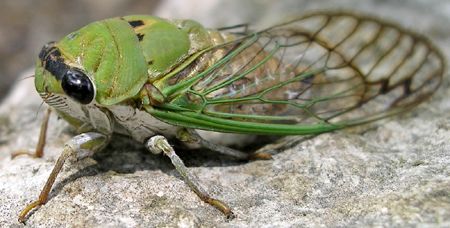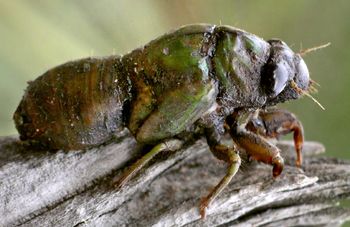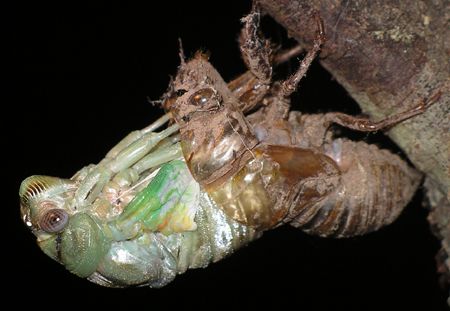
the lovely green Tibicen superbus
The average cicada is a hefty greenish or brownish bug, about an inch long, with clear wings that extend well beyond the tip of the abdomen. The wide head has beady eyes on the sides.
 the lovely green Tibicen superbus |
Though cicadas are related to aphids, planthoppers, and scale insects, they differ so much from these tiny (and silent) animals that it is hard to see the similarities. They do all feed on plants, sucking liquids through tube-shaped mouthparts, and they all develop through gradual metamorphosis (no pupa stage). A very common colloquial name for cicadas is "locust." This can be confusing because locust also refers to grasshoppers, which are a completely different sort of animal that has large hind legs for jumping and is famous for devastating crops.
Although they are relatively large for insects, different cicada species are different sizes. When people see the diminutive Pacarina puella, which is about half the size of most other cicadas, their first response is often to comment on the "cute baby cicada." The obvious error in this is that it has wings, which is a definitive sign of insect adulthood.
Only a few insects are capable of singing in a range that humans can hear, so that talent is rather exceptional. Unlike crickets and katydids, which produce their songs with specially modified wings, male cicadas have structures called tymbals on the sides of their bodies. The vibration to produce the noise is accomplished by abdominal muscles. If you hold a cicada that is singing, it feels like a rather mild sort of practical joke hand buzzer. One of our species, Tibicen texanus, has a particularly long and constant call. I once found an individual that was singing and when I grabbed him, the darn bug continued to vibrate and call, not missing a beat. Very determined, that guy was.
The decibel levels of cicada calls are the stuff of legends. It has been demonstrated that the alarm call of Tibicen resh, a common species here in central Texas, is one of the loudest sounds made by an insect in the United States. Cicadas often produce calls exceeding 100 decibels. When a lot of them are singing together, it can get rather irritating.
 a not-so-lovely, and rather muddy, cicada nymph |
Although it is easy to hear cicadas in trees, and even pinpoint which tree they are calling from, actually finding the bugs is quite difficult. The sound seems to shift, as the insect moves slightly, and, in fact, each male wants to attract a female but not predators. Cicadas remain relatively still on the branches and their camouflage makes them blend right in with the bark. They might be big, but trees are still bigger, and the maze of branches provides excellent protection from searching eyes.
Exceptional camouflage notwithstanding, cicadas are a major part of the food chain and provide important nourishment to all manner of different animals. From other insects to mammals, predators find these chunky creatures to be perfect packages of protein, whether it is to feed a brood of nestlings or provide a larder for a single wasp grub's entire development. Once, as I was watering in our yard, a cicada was calling from a tree right above me. A huge wasp flew in towards the sound, the call changed to a frantic sounding alarm, and a moment later stopped. The wasp had delivered its paralyzing sting. Shortly after that, I saw the wasp, carrying a load bigger than itself, fly off with its prize.
Cicadas are even more at risk when they fly. They are not particularly fast or maneuverable in the air, and birds seem to have little trouble intercepting them. Even grackles, which do not regularly hunt on the wing, pick them off with apparent ease.
While many insects are edible and are on the menu for numerous mammals (a conspicuous exception is Homo sapiens), cicadas seem to be even more tantalizing than usual. Every dog I've known, including those that don't normally eat insects, has relished them. Our current pooch, Periwinkle, is always on the alert during summertime morning walks for the occasional special treat that might be sitting on the sidewalk after a night of flying around street lights. If it attempts to fly away, the slow takeoff merely adds the enticement of a lively game to the tasty reward.
There are two major kinds of cicadas: the annual and the periodical. The former live for just a couple of years underground and have overlapping life spans, with some emerging every year, while the latter fall into well-documented "broods" that include either 13 or 17 year life cycles. While we do not have any of the periodical Magicicada species here in Austin, I have fond memories of the 1973 emergence of Brood XIII, the Northern Illinois Brood, when I was a teenager in Lemont, IL, just south of Chicago. That summer was filled with the raucous noise produced by thousands of black and red insects which had spent the past 17 years as nymphs underground. For a month, they were EVERYWHERE, to the extent that hiking on woodland trails meant stepping on them, roads were covered with their smashed bodies, and there was rarely silence. Our pet turtles and dogs gorged on the insects, putting on obvious extra poundage. People in the area wrapped aluminum foil around their tree trunks to keep the cicadas from climbing up. I couldn't see the point of this since cicadas can fly and managed to get into the trees anyway. I think that just seeing scores of nymphs crawling up the bark
 Tibicen resh eclosing |
One of the most remarkable aspects of cicadas is the molt that takes place when the adult emerges from the nymph skin. This is called eclosing, and it is a rather leisurely process with such a large bug. Evening is the most common time for nymphs to leave their underground tunnels and climb up to molt. I usually find them on our house or trees, but once a resourceful insect used a saxophone case resting next to my chair in the pit band during an outdoor performance of the musical "Annie." No matter where you find them, while the nymph is still crawling, it can be moved to a convenient place for viewing. I recommend a lampshade on a table, out of reach of the family dog. Once the nymph feels it has crawled as high as it can, it anchors its legs, the back skin splits, and the adult starts to squeeze out. The whole process lasts well over an hour, so it is ideal for photographing or just casual viewing. The newly eclosed adult is a pretty light greenish color and at this stage is called teneral. I could see having these as snacks because they are very much like a soft-shelled crab and those are delicious. Once the cicada is completely out of its old skin (called an exuviae), it must wait a LONG time for its exoskeleton to harden completely. The wings, which were pumped up with extra liquid in the veins, have to drain and become hard enough to carry all that weight during flight. It's a good idea, if you do not intend to eat the teneral insect, to put it outside sometime before this final stage, since it will not only pee out the extra liquid (which might not be desirable on your lampshade), but will also eventually want to fly and it is a little chaotic trying to catch it in the house.
As an integral part of the ecosystem, from aerating soil to providing food for nesting birds, the study of this one kind of creature provides a relatively simple look at how nature works. Whether learning to recognize their different songs, identify the markings on the various species, or watch their engaging metamorphosis, they are an easily accessible animal to study. This year's cicada season here in central Texas has just ended, but they are reliable and we can look forward to next year's entertainment.